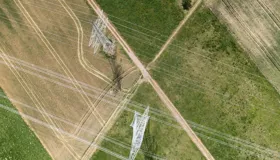
Blind Creek project combines solar, storage and sheep
Ideally located to boost the clean energy transition
The 300 MW Blind Creek Solar and Battery Project, which was developed in close partnership with local landholders to enable sheep grazing to continue at the site, will be able to power more than 120,000 homes and is expected to make a significant contribution to the NSW energy transition.
$9.9m
CEFC investment
300 MW
solar + 243 MW battery storage
Award-winning
community engagement
We believe hybrid solar, storage and agriculture projects are the best way to optimise firmed generation and land usage.Sonia TeitelCo-Head of Investment and Development, Octopus Australia
Our investment
The CEFC invested $9.9 million in the Blind Creek Solar and Battery Project, a farmer-led development that combines renewable energy expertise with understanding of the land, farming practices and knowledge of the local community.
The original CEFC investment of $5 million in 2022, was part of a joint venture with Octopus Australia to develop renewable energy assets in regional Australia, and this was increased through follow-on investments. The project was sold in November 2025, at the commencement of construction, to the Octopus Australia Sustainable Investments Fund (OASIS). The CEFC has invested $150 million in OASIS.
Blind Creek is at a strategic part of the existing transmission network near Bungendore, NSW, between the major load centres of Sydney and Canberra.
Once complete, the 300 MW Blind Creek Solar Project is expected to generate enough electricity to power more than 120,000 homes. Combined with its 243 MW / 486 MWh battery, the project is expected to make a significant contribution to the NSW energy transition without requiring major transmission works.
Octopus Australia is a subsidiary of the Octopus Group, which is one of the world’s largest investors in clean energy.
our impact
Hybrid solar, agriculture project optimises land use
The Blind Creek Solar and Battery project was founded by farmers with a multi-generational connection to the site and to the local community, together with a team of renewable energy experts. The project vision is to co-locate regenerative agriculture with solar, engage in genuine community consultation and include the community in the project’s financial benefits.
The project is working to achieve solar energy production that co-exists with organic grass-fed lambs, regenerative agriculture, a soil carbon sequestration project, restoration of biodiversity and green waste humus production.
From the outset our goal was to co-locate renewable energy with regenerative agriculture and carbon sequestration while maintaining sheep production. We also had a clear vision of how we wanted to involve our local community in the Project. Our relationship with Octopus and the CEFC means our commitment to create a more sustainable future for our family farm and positive outcomes for our community has taken an exciting step forward.Dominic OsborneFounder and Landowner, Blind Creek Solar and Battery Project
Sheep and panels go together
At Blind Creek, grass species suited to shade will be planted immediately under the panels for prime lamb grazing. Normal grass species and cover crop species will be planted in the areas between the panels. The solar farm will co-exist with rotational grass-fed lamb production, allowing for very short periods of intensive grazing. Panel spacing is designed to allow tractor access and grassland enhancements for grazing lambs. The site is flat and sandy, with the project designed to allow animal production to continue on the land as it has for 155 years.
Award winner
The project won the 2022 Clean Energy Council Community Engagement Award for its benefit sharing scheme and agrisolar initiatives.
The Clean Energy Council acknowledged the project’s extensive community engagement process and its work with the local community to pioneer a scheme that will share $3.5 million in benefits with neighbours and the community over the project’s lifetime. The Clean Energy Council also recognised the agrisolar project for being “specifically designed to co-exist with sheep grazing, regenerative agriculture, a soil carbon sequestration project and biodiversity restoration.




